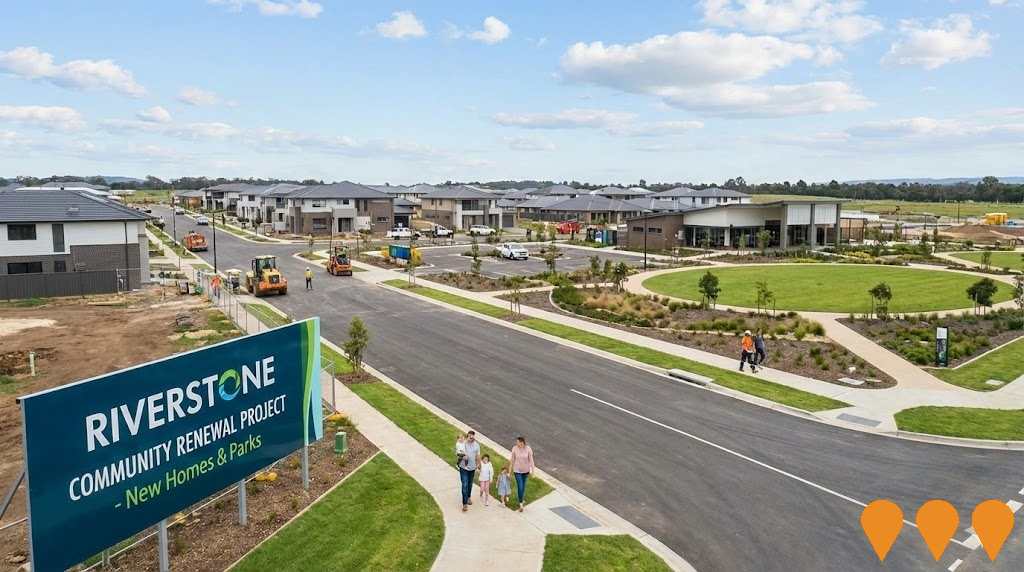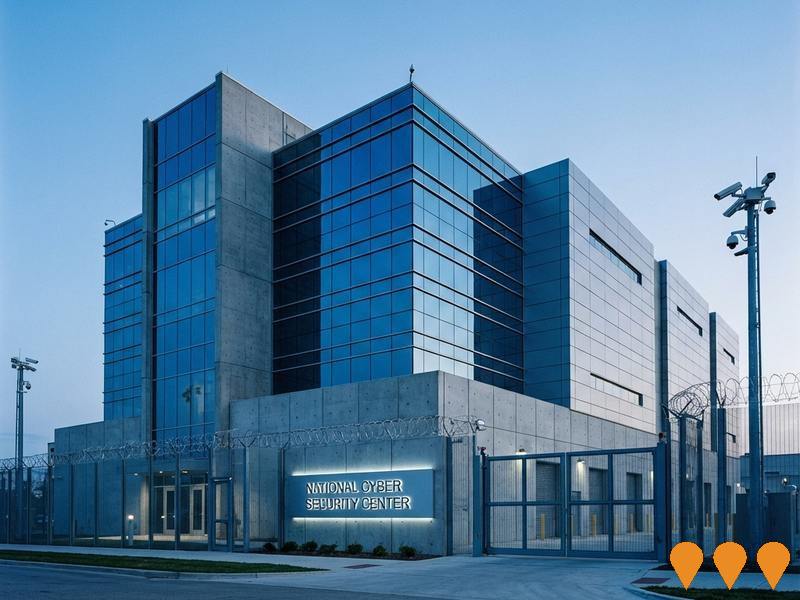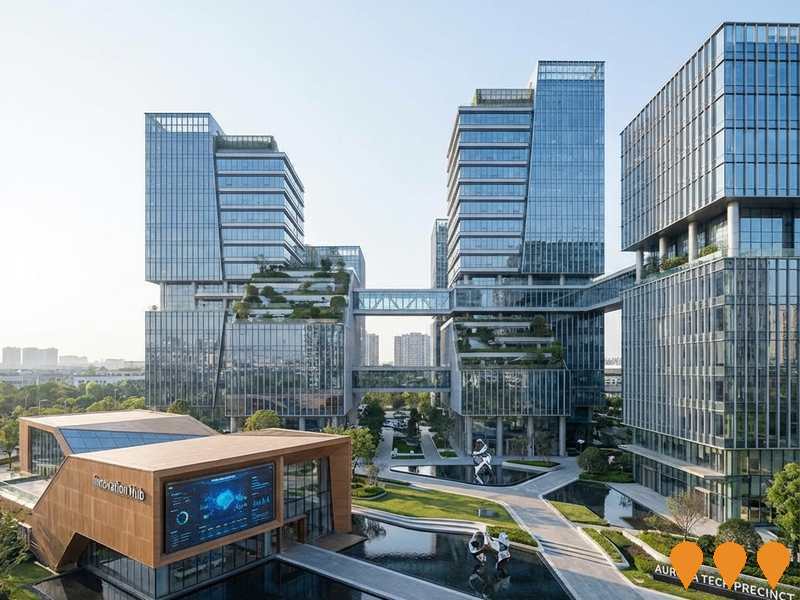Chart Color Schemes
est. as @ -- *
ABS ERP | -- people | --
2021 Census | -- people
Sales Activity
Curious about local property values? Filter the chart to assess the volume and appreciation (including resales) trends and regional comparisons, or scroll to the map below view this information at an individual property level.
Find a Recent Sale
Sales Detail
Population
Mulgoa - Luddenham - Orchard Hills lies within the top 10% of areas nationally in terms of population growth performance according to AreaSearch analysis of short and medium-term trends
Based on AreaSearch's analysis, Mulgoa - Luddenham - Orchard Hills' population was around 13,371 as of Aug 2025. This reflected an increase of 1,331 people (11.1%) since the 2021 Census, which reported a population of 12,040 people. The change was inferred from the estimated resident population of 13,127 from the ABS as of June 2024 and an additional 369 validated new addresses since the Census date. This level of population equated to a density ratio of 84 persons per square kilometer. Mulgoa - Luddenham - Orchard Hills' growth of 11.1% since the 2021 census exceeded the SA4 region's growth of 5.3%, along with the state, marking it as a growth leader in the region. Natural growth contributed approximately 40.5% of overall population gains during recent periods, although all drivers including interstate migration and overseas migration were positive factors.
AreaSearch adopted ABS/Geoscience Australia projections for each SA2 area, released in 2024 with 2022 as the base year. For areas not covered by this data, AreaSearch utilised NSW State Government's SA2 level projections, released in 2022 with 2021 as the base year. Growth rates by age group from these aggregations were applied to all areas for years 2032 to 2041. Considering projected demographic shifts, exceptional growth was predicted over this period, with the area expected to increase by 15,230 persons to 2041 based on the latest population numbers, recording a gain of 112.1% in total over the 17 years.
Frequently Asked Questions - Population
Development
AreaSearch assessment of residential development activity positions Mulgoa - Luddenham - Orchard Hills among the top 25% of areas assessed nationwide
Mulgoa-Luddenham-Orchard Hills has seen approximately 112 new homes approved annually over the past five financial years, totalling 561 homes. As of FY26, 11 approvals have been recorded. On average, 3.1 new residents arrive per dwelling constructed each year between FY21 and FY25. This indicates supply lagging demand, potentially leading to heightened buyer competition and pricing pressures.
New homes are being built at an average construction cost of $572,000. In FY26, $327.8 million in commercial approvals have been registered, suggesting strong commercial development momentum. Compared to Greater Sydney, Mulgoa-Luddenham-Orchard Hills records 54.0% more development activity per person. However, development activity has moderated recently. New building activity consists of 59.0% detached houses and 41.0% townhouses or apartments, expanding medium-density options and creating a mix of housing opportunities across price brackets.
This marks a significant shift from the current 93.0% houses pattern, potentially due to diminishing developable land availability and evolving lifestyle preferences. With around 245 people per dwelling approval, Mulgoa-Luddenham-Orchard Hills is developing as a market. Future projections indicate an addition of 14,986 residents by 2041. At current development rates, housing supply may struggle to match population growth, potentially heightening buyer competition and supporting price increases.
Frequently Asked Questions - Development
Infrastructure
Mulgoa - Luddenham - Orchard Hills has moderate levels of nearby infrastructure activity, ranking in the 46thth percentile nationally
Changes to local infrastructure significantly influence an area's performance. AreaSearch has identified a total of 111 projects likely to impact the area. Key projects include Everdene (Glenmore Park Stage 3), Everdene, Highland Views, and M12 Motorway. The following list details those most relevant.
Professional plan users can use the search below to filter and access additional projects.
INFRASTRUCTURE SEARCH
 Denotes AI-based impression for illustrative purposes only, not to be taken as definitive under any circumstances. Please follow links and conduct other investigations from the project's source for actual imagery. Developers and project owners wishing us to use original imagery please Contact Us and we will do so.
Denotes AI-based impression for illustrative purposes only, not to be taken as definitive under any circumstances. Please follow links and conduct other investigations from the project's source for actual imagery. Developers and project owners wishing us to use original imagery please Contact Us and we will do so.
Frequently Asked Questions - Infrastructure
Sydney Metro Western Sydney Airport - Orchard Hills Station
Construction of a new metro station at Orchard Hills as part of the $11 billion Sydney Metro Western Sydney Airport line. The station, located on the eastern side of Kent Road, will service a future mixed-use precinct and house the line's stabling and maintenance facility. The project is being delivered by the Parklife Metro consortium and will connect St Marys to the new Western Sydney Airport and Aerotropolis.

Hilton Garden Inn Sydney Kingswood (formerly Somerset Medi-Hotel)
Seven-storey hotel development featuring 140 guest rooms, rooftop bar with Blue Mountains views, full-service restaurant and bar, meeting facilities, fitness room, and three basement levels with 63 parking spaces. Located directly opposite Nepean Hospital in the Nepean Health Hub precinct, the facility is designed to serve medical patients, visitors, and general travelers. Originally proposed as a medi-hotel by Boston Global, the project is now planned to operate as a Hilton Garden Inn managed property.

Everdene
Everdene is a 206-hectare masterplanned community by Mirvac located in Glenmore Park (Stage 3), Penrith LGA. The estate will deliver approximately 2,300 new homes including detached houses, duplexes and townhomes on lots ranging 300-700sqm. Features include over 50 hectares of open space, multiple parks, sporting fields, playgrounds, a future community centre and cafe, riparian corridors and extensive walking/cycle paths. Construction of civil works and first home releases are now underway.

Northern Gateway Precinct
A specialised centre within the Western Sydney Aerotropolis, linking Western Sydney Airport with the Greater Penrith area. It is planned to be an employment precinct with supporting residential areas, and will expand from the Sydney Science Park. Proposed uses include freight, logistics, technology, commercial enterprise, and residential areas accessible via a future metro station. The Aerotropolis Precinct Plan, which includes the Northern Gateway, was finalised in March 2022.

M12 Motorway
16-kilometre east-west toll-free motorway between M7 Motorway at Cecil Hills and The Northern Road at Luddenham, providing direct access to Western Sydney International Airport. Part of $4.4 billion Western Sydney Infrastructure Plan. Features 18 bridges, four lanes with provision for six, grade-separated interchanges including airport interchange, shared user paths, and wildlife corridors. Three construction packages: west section (6km by CPB Georgiou JV), central section (7.5km by Seymour Whyte), and east section connecting to M7. Construction commenced August 2022, expected completion early 2026. Expected daily traffic of 52,000 vehicles with travel time savings of up to 16 minutes.

Glenmore Village
A completed mixed-use development featuring 145 residential apartments across three buildings, situated above a retail precinct anchored by Woolworths Metro and including over 40 specialty stores and services. The development has created a vibrant community hub with convenient access to shopping, dining, lifestyle amenities, medical services, gyms, and a swim centre. Officially opened in June 2024.

Mulgoa Road Upgrade - Glenmore Parkway to Jeanette Street
The NSW Government is planning to widen and upgrade Mulgoa Road between Glenmore Parkway to Jeanette Street to support current and future traffic demands and expected growth in the area. The 850m upgrade will improve road safety and travel times, and reduce congestion by adding a lane in each direction. The project includes replacement of the roundabout at Glenmore Parkway with traffic lights, three lanes approaching the intersection, upgraded intersection at Spencer Street/Schoolhouse Road, and shared paths on both sides of the upgraded road.

M12 Motorway - Western Package (M12 West)
The Western Package (M12 West) delivers about 6.1 km of the new M12 Motorway between The Northern Road at Luddenham and east of Badgerys Creek. Scope includes 11 bridges, a grade-separated interchange providing access to Western Sydney International Airport, a dual-carriageway four-lane airport access road, and a shared path. As of August 2025 the project is reported to be over 90% complete, with completion targeted for late 2025.

Employment
The exceptional employment performance in Mulgoa - Luddenham - Orchard Hills places it among Australia's strongest labour markets
Mulgoa-Luddenham-Orchard Hills has a skilled workforce with the construction sector prominently represented. As of June 2025, its unemployment rate is 1.3%.
In this month, 7,589 residents are employed while the area's unemployment rate is 2.9% lower than Greater Sydney's rate of 4.2%. Workforce participation in Mulgoa-Luddenham-Orchard Hills stands at 69.5%, exceeding Greater Sydney's 60.0%. Employment among residents is concentrated in construction, health care & social assistance, and retail trade. Notably, the area has a high employment specialization in construction, with an employment share of twice the regional level.
Conversely, professional & technical services are under-represented, with only 5.3% of Mulgoa-Luddenham-Orchard Hills' workforce compared to Greater Sydney's 11.5%. AreaSearch analysis over the year to June 2025 shows a decrease in labour force levels by 2.3%, accompanied by a similar employment decrease while unemployment remains stable. Meanwhile, Greater Sydney recorded employment growth of 2.6% and labour force growth of 2.9%, with a slight rise in unemployment. Jobs and Skills Australia's national employment forecasts from May 2025 project national employment growth of 6.6% over five years and 13.7% over ten years, but industry-specific projections vary significantly. Applying these projections to Mulgoa-Luddenham-Orchard Hills' employment mix suggests local growth could be approximately 6.2% over five years and 12.7% over ten years.
Frequently Asked Questions - Employment
Income
The economic profile demonstrates exceptional strength, placing the area among the top 10% nationally based on comprehensive AreaSearch income analysis
Mulgoa - Luddenham - Orchard Hills had a median taxpayer income of $61,765 and an average of $83,381 in financial year 2022. These figures are significantly higher than Greater Sydney's median income of $56,994 and average income of $80,856. By September 2025, estimated incomes would be approximately $69,554 (median) and $93,895 (average), based on a 12.61% increase since financial year 2022. According to the 2021 Census, household, family, and personal incomes in Mulgoa - Luddenham - Orchard Hills ranked between the 81st and 94th percentiles nationally. The largest income segment comprised 30.5% earning $1,500 - $2,999 weekly, with 4,078 residents falling into this category. This is consistent with broader trends across the region, where 30.9% of residents earned within the same range. Economic strength is evident through 43.9% of households achieving high weekly earnings exceeding $3,000, which supports elevated consumer spending. High housing costs consume 15.5% of income in the area, but strong earnings still place disposable income at the 94th percentile nationally. The area's SEIFA income ranking places it in the 8th decile.
Frequently Asked Questions - Income
Housing
Mulgoa - Luddenham - Orchard Hills is characterized by a predominantly suburban housing profile, with above-average rates of outright home ownership
Mulgoa - Luddenham - Orchard Hills' dwelling structure, as per the latest Census, consisted of 93.1% houses and 6.9% other dwellings. In comparison, Sydney metro had 77.4% houses and 22.6% other dwellings. Home ownership in Mulgoa - Luddenham - Orchard Hills stood at 31.5%, with mortgaged dwellings at 49.5% and rented ones at 19.0%. The median monthly mortgage repayment was $2,773, higher than Sydney metro's average of $2,167. The median weekly rent in the area was $530, compared to Sydney metro's $400. Nationally, Mulgoa - Luddenham - Orchard Hills' mortgage repayments were significantly higher than the Australian average of $1,863, and rents were substantially above the national figure of $375.
Frequently Asked Questions - Housing
Household Composition
Mulgoa - Luddenham - Orchard Hills features high concentrations of family households, with a higher-than-average median household size
Family households constitute 86.1% of all households, including 52.0% couples with children, 23.0% couples without children, and 10.2% single parent families. Non-family households account for the remaining 13.9%, with lone person households at 12.6% and group households comprising 1.2%. The median household size is 3.3 people, larger than the Greater Sydney average of 2.8.
Frequently Asked Questions - Households
Local Schools & Education
Educational attainment in Mulgoa - Luddenham - Orchard Hills aligns closely with national averages, showing typical qualification patterns and performance metrics
The area has university qualification rates at 23.0%, substantially below Greater Sydney's average of 38.0%. This presents both a challenge and an opportunity for targeted educational initiatives. Bachelor degrees are the most common at 15.5%, followed by postgraduate qualifications (5.5%) and graduate diplomas (2.0%). Trade and technical skills are prominent, with 36.8% of residents aged 15+ holding vocational credentials – advanced diplomas at 10.9% and certificates at 25.9%.
Educational participation is high, with 31.1% of residents currently enrolled in formal education. This includes 11.5% in primary education, 9.0% in secondary education, and 4.4% pursuing tertiary education. A total of 10 schools operate within Mulgoa - Luddenham - Orchard Hills, educating approximately 4,140 students. The area has typical Australian school conditions (ICSEA: 1026) with balanced educational opportunities. The educational mix includes 6 primary and 4 K-12 schools. The area functions as an education hub with 31.0 school places per 100 residents, significantly above the regional average of 16.6, attracting students from surrounding communities.
Frequently Asked Questions - Education
Schools Detail
Nearby Services & Amenities
Transport
Transport servicing is moderate compared to other areas nationally based on assessment of service frequency, route connectivity and accessibility
Mulgoa-Luddenham-Orchard Hills has 93 active public transport stops. These are served by 88 bus routes, offering a total of 1,630 weekly passenger trips. Residents' average proximity to the nearest stop is 269 meters.
Daily service frequency averages 232 trips across all routes, equating to about 17 weekly trips per individual stop.
Frequently Asked Questions - Transport
Transport Stops Detail
Health
Mulgoa - Luddenham - Orchard Hills's residents boast exceedingly positive health performance metrics with very low prevalence of common health conditions across all age groups
Mulgoa-Luddenham-Orchard Hills shows excellent health outcomes, with very low prevalence of common conditions across all ages. Private health cover is high at approximately 61% (8,196 people), compared to Greater Sydney's 53.8%. Nationally, it stands at 55.3%.
The most prevalent conditions are asthma and mental health issues, affecting 6.6% and 6.0% respectively. A total of 75.1% report no medical ailments, higher than Greater Sydney's 69.5%. The area has 12.8% seniors (1,712 people), lower than Greater Sydney's 14.1%. Senior health outcomes align with the general population's profile.
Frequently Asked Questions - Health
Cultural Diversity
The level of cultural diversity witnessed in Mulgoa - Luddenham - Orchard Hills was found to be above average when compared nationally for a number of language and cultural background related metrics
Mulgoa-Luddenham-Orchard Hills has a cultural diversity above average, with 20.3% of its population born overseas and 19.1% speaking a language other than English at home. Christianity is the main religion in Mulgoa-Luddenham-Orchard Hills, comprising 68.6% of people, compared to 57.9% across Greater Sydney. The top three ancestry groups are Australian (25.0%), English (22.1%), and Other (9.4%).
Notably, Maltese is overrepresented at 6.2%, Croatian at 1.5%, and Lebanese at 1.9%.
Frequently Asked Questions - Diversity
Age
Mulgoa - Luddenham - Orchard Hills's population is younger than the national pattern
Mulgoa-Luddenham-Orchard Hills has a median age of 35 years, which is slightly younger than Greater Sydney's 37 and the national average of 38. The 5-14 age group makes up 15.6%, compared to Greater Sydney. However, the 25-34 cohort stands at 11.5%. Between 2021 and now, the 75-84 age group has increased from 3.6% to 4.5%, while the 25-34 cohort has decreased from 12.3% to 11.5%. By 2041, forecasts suggest significant demographic changes. The 45-54 age cohort is projected to grow by 2,528 people (146%), from 1,731 to 4,260.





